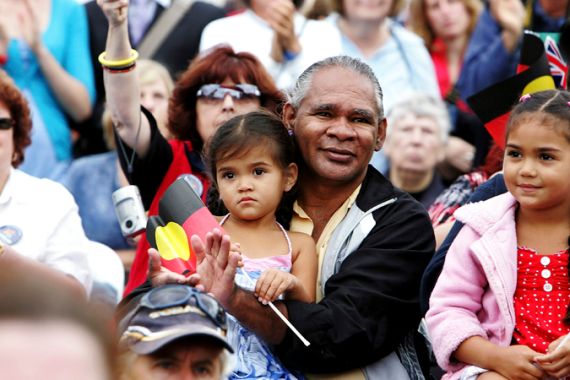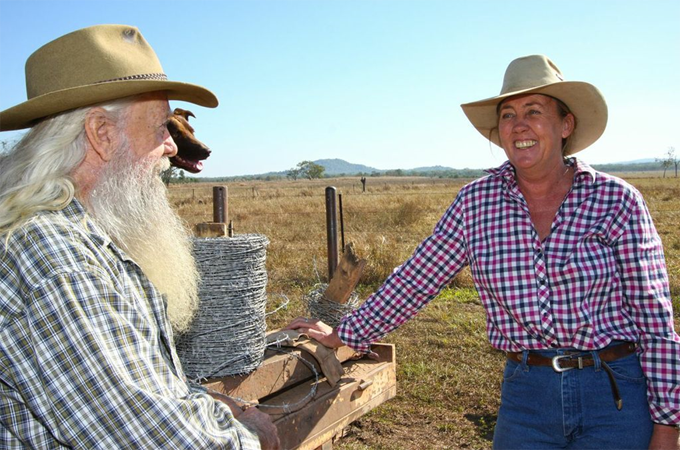Aborigines sour on Australia’s Labor Party
Angry over federal intervention in the Northern Territory, indigenous voters could sway upcoming polls.

A flood of asylum seekers, border security, climate change and a controversial second chance for previously-axed Prime Minister Kevin Rudd are among the headlines influencing Australian voters as they prepare to elect a federal government on September 7.
But largely missing from this picture is a tragedy that has been unfolding at the heart of the nation for more than a century – the plight of Australia’s indigenous people, the Aborigines and Torres Strait Islanders. Often a convenient platform for domestic political grandstanding, indigenous Australia receives scant attention in frontline election coverage.
Yet the electoral district of Lingiari, which comprises most of Australia’s largely undeveloped Northern Territory, is emerging as a litmus test for the political leanings of Aborigines and whites alike. Once considered a safe seat for the centre-left Australian Labor Party, incumbent Warren Snowdon’s future is now in doubt, according to political analyst Professor Rolf Gerritsen of the Northern Institute at Charles Darwin University.
“Aboriginal voters are fed up with being told what to do by governments,” Gerritsen told Al Jazeera. “The federal intervention of 2007 sums up the breadth of the issues. At the last Territory election, voting for the Country Liberal Party was the only way for Aboriginal people to say to the state: ‘stop bothering us’.”
Lingiari covers an area roughly twice the size of France and comprises 99 percent of the Territory’s land area. It includes the towns of Katherine, Tennant Creek, the regional urban hub of Alice Springs in Central Australia, and an array of pastoral leases, remote Aboriginal communities and smaller settlements called outstations. Lingiari also includes Christmas Island and the Cocos Islands to the north.
|
|
| 101 East – Australia’s Lost Generation |
As Gerritsen points out, Lingiari is the nation’s only truly “Aboriginal” electorate, with 40 percent of the voting population identifying as indigenous, people who do not speak English as a first language at home, compared with just two percent in Australia as a whole.
Warren Snowdon, the federal minister for indigenous health, has held the seat of Lingiari for all but two years since 1987. Widely considered the spiritual heart of Australia, Lingiari, and in particular Central Australia, have become something of a proving ground for Australia’s efforts toward reconciliation with Aborigines.
Alice Springs, where Snowdon is based, is home to just over 25,000 people, according to census data. Roughly one-quarter are Aboriginal, with up to 2,000 living in 18 fringe camps at the edges of the town.
Now Lingiari is set to become a battleground over attitudes for and against recent federal intervention into Northern Territory affairs. For the Rudd government, which governs only by the narrowest of margins, and courtesy of a difficult alliance with independents, the news must be unsettling.
‘Stabbing capital’
Widespread alcohol abuse and violence among Aborigines across Lingiari, as well as poorly directed government policy for decades, has left the region with third-world rates of disease, violence and disadvantage. Alice Springs has earned the nickname of the world’s “stabbing capital”, after a widely publicised report in the ANZ Journal of Surgery revealed the number of knife wounds treated at the local hospital.
Six years ago, the Australian army was sent in to restore order in the Northern Territory. Widely dubbed “the federal intervention”, the bold, military-backed action by then Prime Minister John Howard was continued under Rudd and made headlines across the globe. Its stated purpose was to fight child sexual abuse and enforce Australian law at remote settlements dotted across the deserts comprising much of Australia’s dry inland.
Critics say the move was to secure land tenure ahead of expected growth in Australia’s rich mining industry. Attitudes on the intervention remain mixed and volatile and lie at the heart of much of the discontent in Northern Territory politics.
A 30 percent churn rate among Lingiari’s highly mobile non-Aboriginal demographic makes it difficult to pick voting trends from one year to the next. Still, Gerritsen warns that continuing disaffection over the intervention may take its toll at the ballot box.
“There is not one issue,” he says, “and inevitably the picture is complicated by local matters, such as law and order, or employment. But the overarching issue is the intervention, the effects of which were seen at the last election when there was a 30 percent swing against Snowdon amongst the Aboriginal population.”
At that poll, Snowdon’s loss of support was offset by increased backing by urban whites, which Gerritsen attributes to disaffection over Leo Abbott, the Aboriginal Country Liberal Party candidate running against Snowdon, who became embroiled in controversy during the campaign.
Ditching Labor
All I have seen is racism and disempowerment of our people. It's the old assimilation policy back again, to control how we live.
In this election, says the professor, Aboriginal voters remain likely to vote against Labor, judging by a pronounced and unfavourable swing in last year’s Territory election, in which the party was unseated after more than a decade in the Territory government. White voter sentiments are harder to determine, says Gerritsen.
Running against Snowdon for the Country Liberal Party is newcomer Tina MacFarlane, who will trade on her long-standing family connections in the Territory’s pastoral industry. On her website, MacFarlane states she intends to “drive for economic efficiency and… work hard to create opportunity and economic development”.
The position is closely aligned with opposition leader Tony Abbott’s stance that Aboriginal lands must be considered both an economic and spiritual asset.
In a statement to Al Jazeera, MacFarlane said, “Labor should have moved on from the intervention, and by now should have been getting people off welfare and into work”.
Land rights activism
In the 1970s, the Territory became the focal point for a debate over land rights. Today, almost one-fifth of the country’s land mass has been handed back to Aborigines, to encourage self-determination.
 |
| Country Liberals candidate Tina MacFarlane says the Labor Party should have ‘moved on’ from the intervention [Glenn Morrison/Al Jazeera] |
Such activism remains in some quarters. Born and raised in an Alice Springs town camp, Barbara Shaw, an Aboriginal activist and mother of two, is challenging Snowdon on the Australian Greens ticket.
Speaking about the intervention, Shaw, 37, told Al Jazeera, “All I have seen is racism and disempowerment of our people. It’s the old assimilation policy back again, to control how we live.”
Shaw opposes the intervention, which continues under the government rubric of Stronger Futures, and agrees it remains a major source of disaffection for voters. “The Greens are calling for a five-year review of Stronger Futures. It was supposed to create jobs in the bush, but it hasn’t. We stand for sustainable communities and families and eventually to bring an end to Stronger Futures, to skill up people in the bush so they can run their own communities.”
But not all Aborigines agree. As Gerritsen observes, “On the left you have Barbara Shaw, who’s against [Stronger Futures]. On the right are the likes of Territory CLP politicians Bess Price and Alison Anderson, who support it. It’s the old conflict between a paternalistic approach and self-determination.”